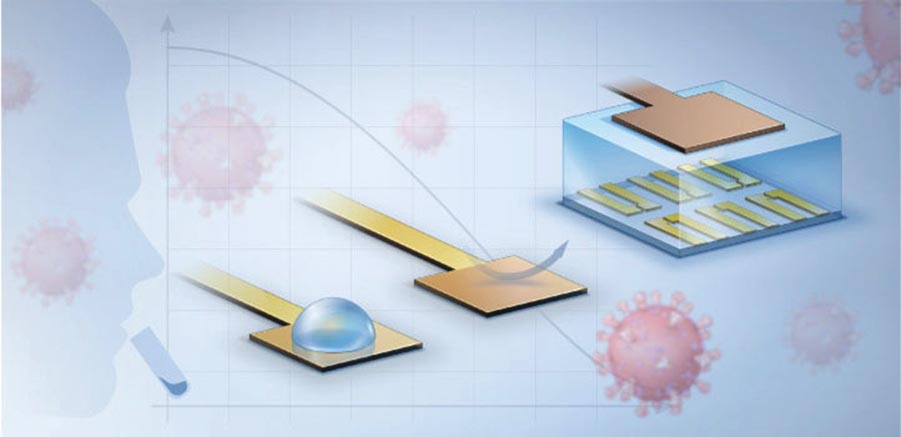New Biosensor Technology Makes Coronavirus Testing Quick and Easy
0 View
Share this Video
- Publish Date:
- 28 May, 2021
- Category:
- Covid
- Video License
- Standard License
- Imported From:
- Youtube
Tags

KAUST scientists have combined state-of-the-art bioelectronic hardware, materials science engineering and synthetic biology protein design to simplify and accelerate coronavirus testing. Credit: © 2021 KAUST; Xavier Pita
A new diagnostic technique could help contain the spread of COVID-19 and other virus outbreaks.
A new rapid coronavirus test developed by KAUST scientists can provide highly accurate results in less than 15 minutes.
The diagnosis, which combines electrochemical biosensors with engineered protein constructs, allows clinicians to quickly detect pieces of the virus with a precision previously only possible with slower genetic techniques. The whole setup can work at the point of patient care on raw blood or saliva samples; no cumbersome sample preparation or centralized diagnostic laboratory is required.
“The combination of state-of-the-art bioelectronic hardware, materials science engineering and synthetic biology protein design really makes it possible to simplify and accelerate coronavirus testing,” said Raik Grünberg, a biochemist at KAUST who co-led the study.
Grünberg and his KAUST colleagues, including Sahika Inal and Stefan Arold, are now working with commercial partners to modify their prototype on a laboratory scale. They hope to create a bench-top, wearable device that can be used to contain the COVID-19 pandemic.
“This biosensor technology can be adapted to detect other pathogens and as such will have a major impact on pandemic management – today and in the future,” said Inal.
Coronavirus testing continues to be important. Despite increasing vaccination coverage in Saudi Arabia and around the world, the number of COVID-19 cases worldwide remains at alarmingly high levels, and public health officials need ways to quickly identify those who have contracted the disease so that they can limit the transmission of viruses.
Current testing paradigms generally fall into two camps: they detect viral RNA through genetic means, which can be slow and involves enzymatic amplification of trace molecular signals, or they trap viral proteins (known as antigens) in ways that are fast but not nearly as fast. to be. accurate.
The new KAUST technique now combines the speed of protein detection with the precision of genetic testing. “Even if there is only one virus particle in a sample, our platform will detect it,” said Keying Guo, a postdoctoral fellow in Inal’s lab and co-author of the study with his KAUST colleagues Shofarul Wustoni and Anil Koklu.
The system starts with a virus-specific nanobody, a type of binding protein that can be designed to attach to fragments of a variety of coronaviruses, including those responsible for COVID-19 and Middle East Respiratory Syndrome (MERS). The nanobody is attached through a series of biochemical linkers to a thin layer of gold that, when an electric current is added, controls the flow of electricity through the semiconductor film to which it is connected. The presence of nanobody-bound viral proteins changes that current, creating a signal that is amplified to measurable levels by a device known as an organic electrochemical transistor.
The researchers initially improved their test on human saliva and blood samples spiked with bits of protein from the coronaviruses that cause MERS and COVID-19. They then worked with doctors from KAUST Health in Thuwal and scientists from the King Faisal Specialist Hospital and Research Center in Riyadh to validate the test on clinical samples, both saliva and nasal swabs, collected from patients.
The speed, versatility and performance compared to standard genetic testing underscore the potential of the new method to complement or possibly replace the existing diagnostics for COVID-19 and any future pandemics.
Reference: “Rapid Detection of Single Molecule COVID-19 and MERS Antigens via Nanobody Functionalized Organic Electrochemical Transistors” by Keying Guo, Shofarul Wustoni, Anil Koklu, Escarlet Díaz-Galicia, Maximilian Moser, Adel Hama, Ahmed A. Alqahtani, Adeel Nazir Ahmad, Fatimah Saeed Alhamlan, Muhammad Shuaib, Arnab Pain, Iain McCulloch, Stefan T. Arold, Raik Grünberg and Sahika Inal, May 24, 2021, Nature Biomedical Engineering.
DOI: 10.1038 / s41551-021-00734-9










